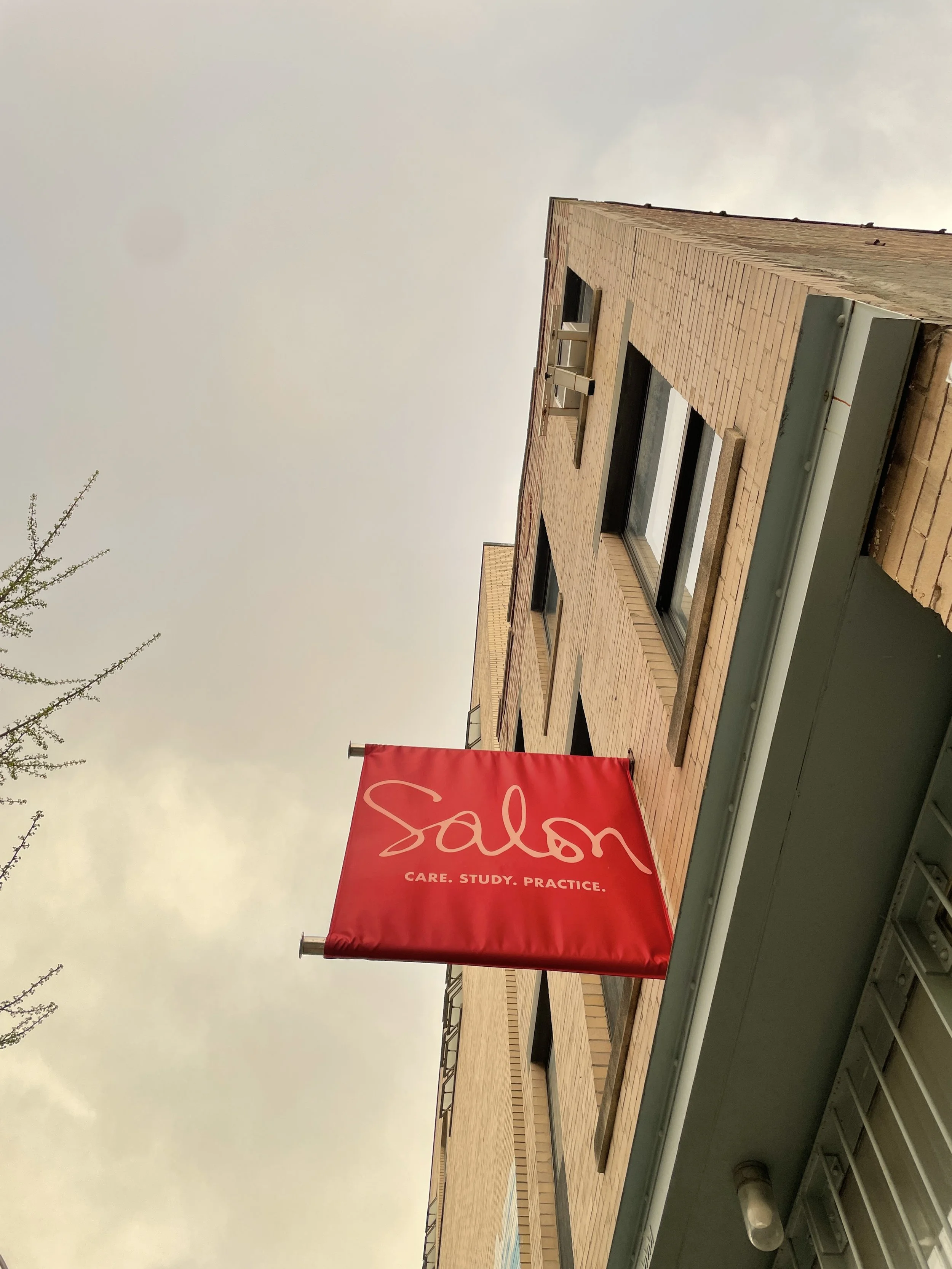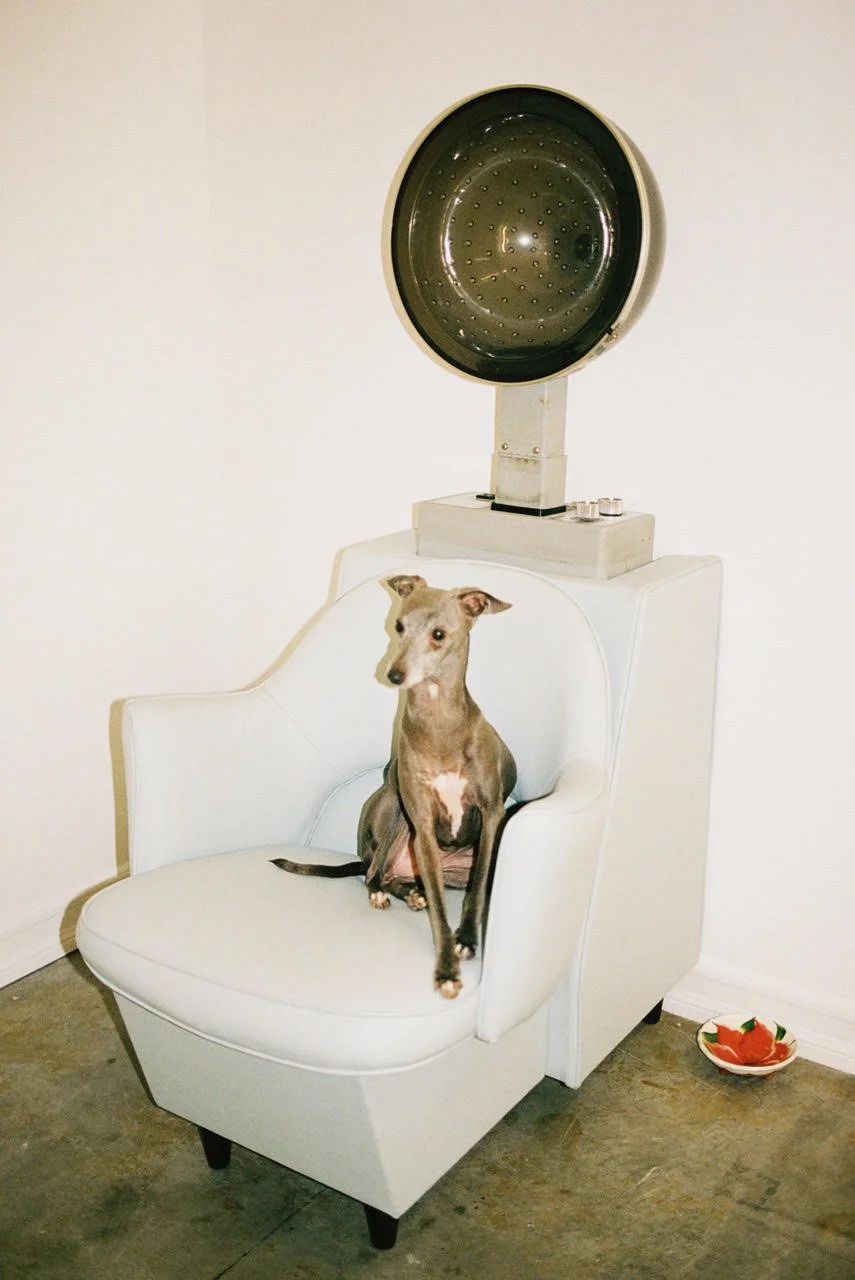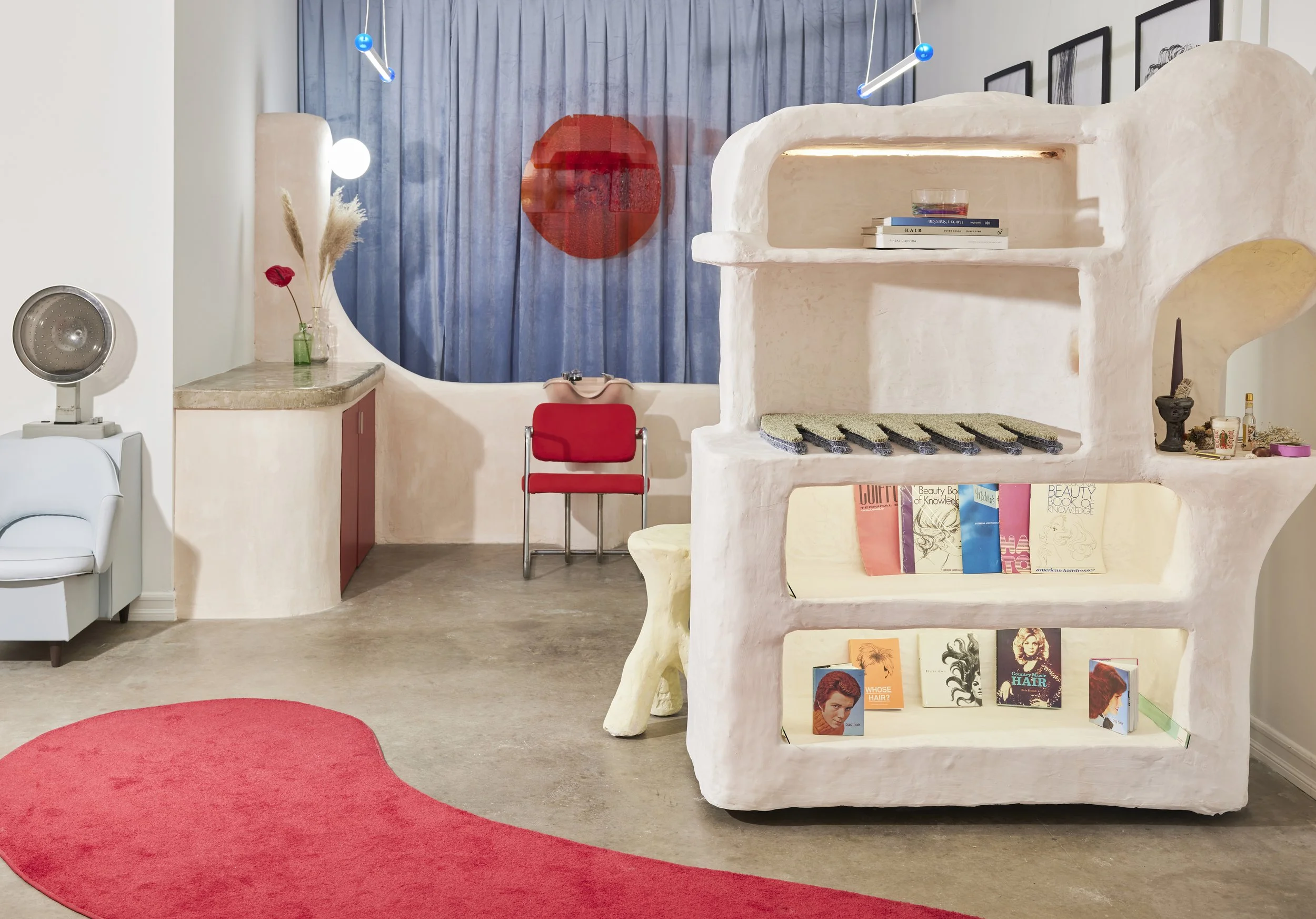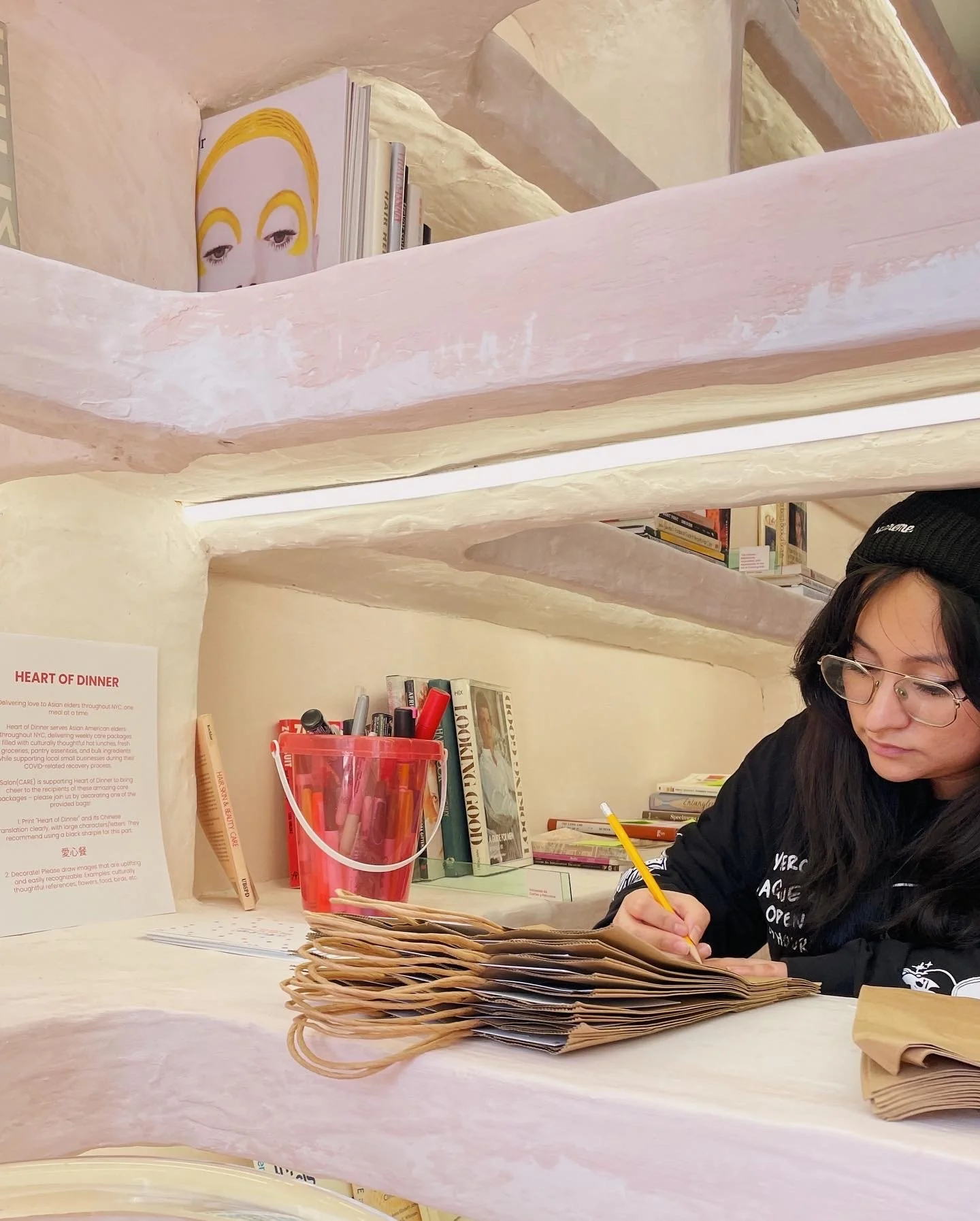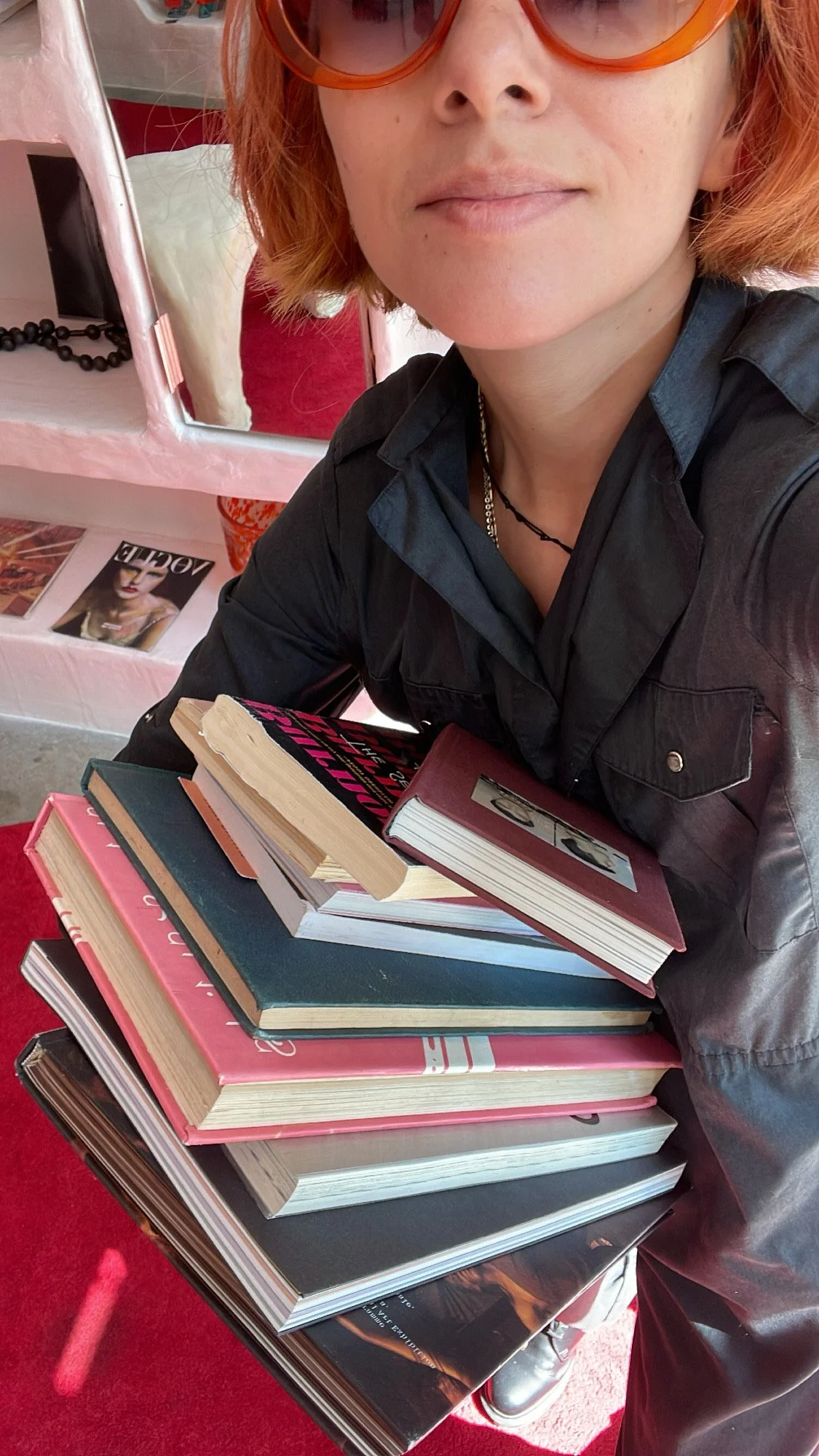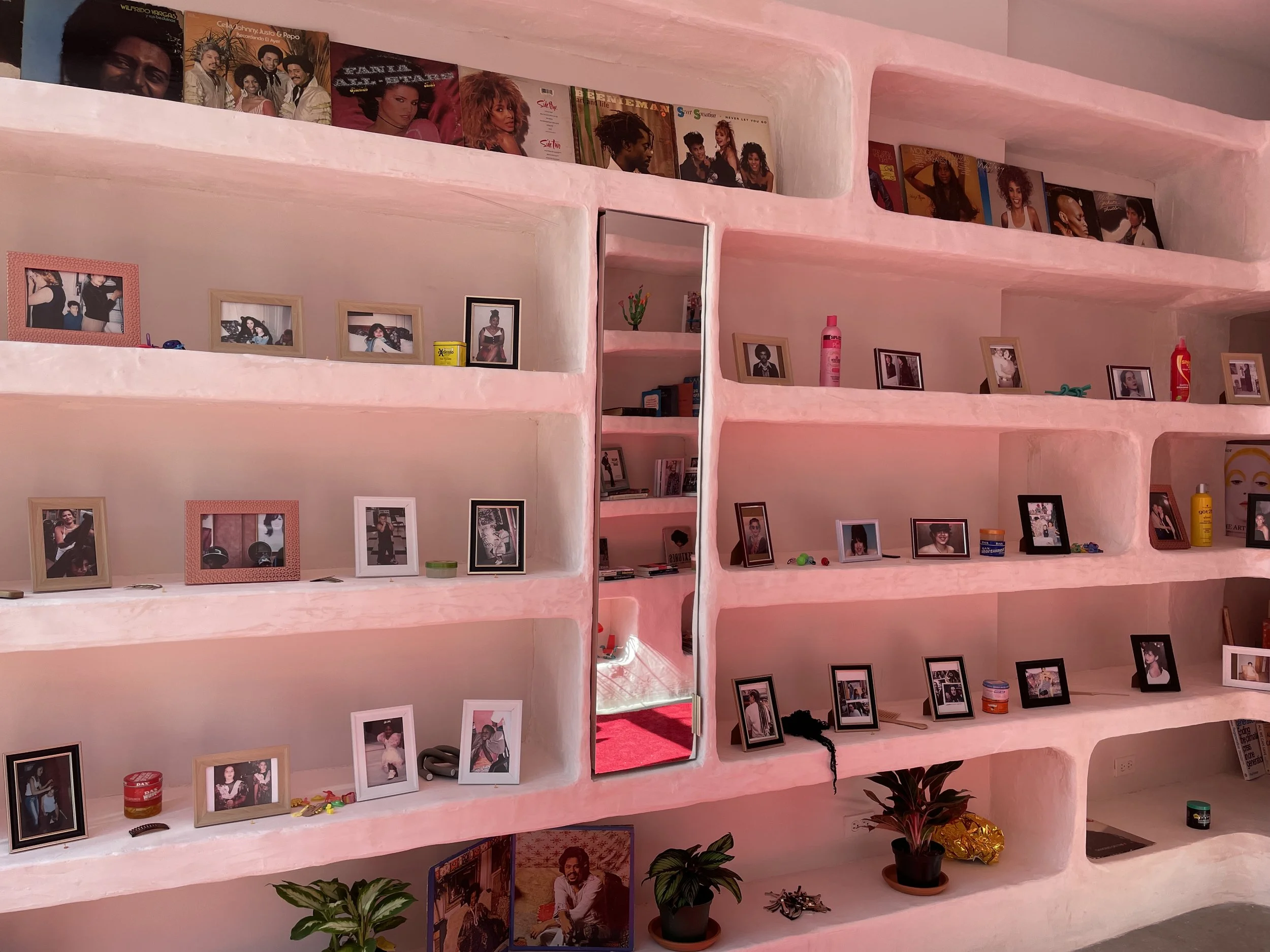Sacred is the Crown: Hair as Holy with Rubi Aguilar of SALON
Self portrait. Courtesy of Rubi Aguilar.
READ IN SPANISH | LEE EN ESPAÑOL
For Black and Brown communities, salons and barbershops have always been sacred. Places that allow us to exist outside of space and time; where we come together, unpack the issues of the day, and sit in community when the times get tough. It’s a place where we laugh and cry, learn and unlearn. Where our perceptions are challenged. Where we take the time to anoint our crowns, no matter how long it takes. Salons and their stylists are vital lifelines in the ecosystems of the communities they serve.
In 2018, hair stylist Rubi Aguilar founded SALON, a creative space equal parts hair salon and library with the goal of fostering community and connection centered around hair. Located in the heart of Los Sures, SALON serves its community through haircare, programming, and their core tenants of (Salon)STUDY—the first and only public library devoted to hair research designed to re-evaluate the way we look at and think of hair—(Salon)CARE initiatives rooted in fundraising, volunteering, and educating salon workers to continue to serve their communities, and (Salon)PRACTICE, a community center and incubator. We speak to Rubi about her journey, SALON’s inception, and the importance of showing up for community.
SALON. Courtesy of Rubi Aguilar.
As a Chicana from the West Coast, what has been your relationship with hair?
I am from the borderlands. For 4 generations, my family lived between the land alongside the beach that intersects the US and Mexico border. My parents home was always filled with visitors and hair was often a part of these visits. Highlight caps and perm solution. That smell transports me back, it’s tias, it’s concrete floors, laughter, laying my head on an ironing board while my cousin straightens my hair, chisme, love, and care above all. We crossed over to Tijuana for haircuts when quinceañeras started surrounding our weekends, Aquanet, curls, blowouts, red Shakira highlights, tresflores, hairnets, and brilliantine. Hairstyling was a part of home and lived in the in-between with me. Hair is love for me. It’s caretaking, it’s thick, it holds stories, it remembers, it asks to be held, braided, intertwined, to release, to adorn. It has always been an extension and expression of oneself.
Thinking back to your upbringing, who were your biggest hair inspirations who ultimately inspired you to embark on a career in the industry?
Growing up, my hair heroines were my mother, my tias, and my grandmothers. They are all style icons who took getting dressed very seriously. For as long as I could remember, my sisters and I would pick outfits from pages of fashion magazines and fall asleep to the sound of my mom sewing them for us. My grandmother would make the more elaborate dresses (Karen Elson’s look in Louis Vuitton fw 04 show for prom), and when my great grandmother could get her hands on it, she’d add sequins,beads, lace, and pearls. When I learned I could do hair on the pages of the same magazines, I set my goals to do just that. I’ll always remember calling my abuelita when my work was on a Soho billboard for the first time.
By Ellen Fedors. Courtesy of Rubi Aguilar.
Calling NYC home for quite some years now, what have been some of the biggest similarities and differences between East and West Coast hair cultures? As an artist, what have both spaces taught you?
When I first moved to New York, I was so aware of the similarities and differences between hair cultures. Back then, California hair was different from New York but I don’t think that's quite as obvious today. I think that social media has affected the way trends and hair culture moves between cities. I still don’t think bonded hair extensions have fully taken over NYC the way they’ve held on in California, but that might be the most specific difference. I think it’s incredibly refreshing when I see subcultures connecting aesthetically between coasts just as much as I love to see completely different aesthetic differences.
What was the impetus behind Salon?
Salon. It’s always been there I guess. A space to gather, share and grow in. I have been doing versions of Salon ever since I moved from New York to Paris in 2012, through pop-ups, intimate events centered around hair, and making zines with stories from my clients. I would say that there were two major moments that drove me to creating this in a more concrete way. One was becoming a mother. I got a studio space after years of storing my hair kit at home and taking it on sets alongside renting a chair at my mentor's salon. Motherhood made it clear that I needed a home for my creativity that was outside my personal home. As that studio slowly attracted more clients, I did more of these Salon events, and by Feb 2020 I realized I’d sort of opened my dream hair salon. The Pandemic was the second impetus to Salon today. So much to say there but similar to the way motherhood gave me clarity on how I wanted to spend the hours and energy I have everyday, the Pandemic clarified that even further. I spent months writing down all the elements I wanted in my work moving forward (a library, hands-on education, community care events…). Everything fell under three pillars that are the ethos of Salon today: Care, Study, and Practice.
By Alpha Smoot. Courtesy of Rubi Aguilar.
By Alpha Smoot. Courtesy of Rubi Aguilar.
Located in the heart of Los Sures, a predominantly Puerto Rican and Dominican neighborhood at the crossroads of gentrification, how do you navigate your role as a newer business owner in a changing neighborhood?
I had to leave my studio in Chinatown (another heavily gentrified neighborhood) in the height of the pandemic. At that time, the new crop of businesses in Chinatown either showed up to serve the community that has been in that neighborhood for generations (especially the elders), or created fundraisers to support their gentrifying friends. I’m not saying you can’t do both, but the way we show up at all times matters. I’m not perfect, nor is there a perfect neighbor but I was very intentional in looking for a new space when I felt I was ready to. I wanted to feel like home and although my home is in Southern California, Los Sures has so many breaths of what feels like home to me. I fully acknowledge that for me to feel like home somewhere is one thing and for the families in that neighborhood to see me as someone who belongs is a completely different one. I have never taken it lightly.
The Chicano movement was a huge inspiration for the way Salon moves and exists. I felt many parallels between the first Chicano artists and the way I felt about institutions and museums/fashion houses in my own career. Chicano artists chose to turn back on these art institutions and bring art to the streets instead and use it to support social justice causes that affected their communities instead. Los Sures has similar roots, the Young Lordes and Brown Berets, and the Williamsburg and Coronado bridge, there are common threads here.
When I moved into Los Sures, I chose not to bring on any stylists to the space for the first year so we can grow within our walls and in our neighborhood before expanding our world to the outside. I chose to first,get to know my neighbors and focus on community work within the 5 blocks of the Salon. Our first event was with you! We did a beautiful show with photos and stories on hair within Los Sures. We also worked with the Los Sures Senior Center, fundraised for organizations like El Puente and provided free care services to our fellow hairstylist neighbors during our annual Care Week which included massages and hand and arm therapy.
Our relationship with our neighbors is exactly that, a relationship, we live and work in relation to each other and continue to nurture it every season. I can’t imagine being anywhere else, listening to Spanish as I walk around our neighborhood, Salsa music, and Bad Bunny on the streets feels like home.
Courtesy of Rubi Aguilar.
As the adage goes, the personal is political. How does this show up in hair?
We recently had a reading night, panel discussion, and fundraiser at SALON titled: Is Beauty (Still, Always) Political? On a personal level, I believe that having hair, removing it, styling it, and showing it in public, have all been politicized in every culture for as long as oral and recorded histories have existed. On a community level, hairdressers have been at the forefront of many political and social justice movements in the US because caring for our communities is what we intrinsically do.
One of my clients who is a therapist came in a few weeks after Trump was re-elected and I asked her: “So, everyone isn’t ok right?” We both see our clients' collective states of being in very vulnerable ways. I have been cutting A LOT of hair off, especially with clients who identified with their long locks, the colorist at SALON has been bleaching hair and eyebrows, and some clients are choosing to grow their hair ultra long. I see these as obvious forms of political resistance and protection.
By Alpha Smoot. Courtesy of Rubi Aguilar.
For communities of color, hair salons and barber shops have always been spaces of refuge, freedom, innovation, and expression. What are some of your earliest memories as salons as safe spaces?
Hair salons in the US were born out of a necessity for safe spaces for women and they have continued to thrive for a long time because these spaces are often overlooked by systems designed to oppress them.
Growing up, I had my hair done in a lot of hairdressers homes. These were safe spaces. Often overlooked, often deemed as unprofessional or lower on the totem pole of what hairdressers should strive for, these salons are the backbone of the hair industry. They are safe because they are designed by the stylist for their specific needs and cater to their communities needs. It’s intimate, it’s home, and it’s taking care with the resources we have. Como dicen las mamás, “hay comida en la casa”.
By Alpha Smoot. Courtesy of Rubi Aguilar.
Equally as important as hair care, Salon is also an educational hub. (Salon) Study is the first and only public library devoted to hair research. What prompted you to create this initiative?
My creative practice has always included library research. I would ask librarians for specific reference paths I’d like to dive into, like an entry point to creative research. For example, portrait photography in Mexico during the 70s, shot by a Mexican photographer because with hair, representation and documenting worlds through their own communities lenses mattered to me then (and still now). Remembering that exact request reminds me that we recently received a book donation that would have been a dream then! To now have a curated selection of books where research paths begin with hair is a dream.
Libraries and salons are community spaces that meet their communities needs. Above all, we are a place for resources and care centered around hair. Everything we do, whether it’s through hairdressing or in our event programming or book/zine publishing is a response to conversations behind the chair and in our library space.
Courtesy of Rubi Aguilar.
Whether folks have appointments or not, you invite all passersby to engage with the library. Why is educational accessibility so important to you?
In my experience, beauty education has existed either behind institutional walls and systems designed to exclude versus the beauty education I grew up with, which is intuitive and freely shared through personal moments and passed across generations. I always felt a push and pull from what felt intuitive to me and what I was taught in beauty school, what I saw stylists do every day behind the chair (personal connections) versus what professional high end salons strived for (separating the personal). There’s a middle ground that I’m hoping to create and nourish at Salon and educational resource sharing is at the heart of it.
The curation of the books focuses on stories we hope to be canon in beauty education and that means that some sections are small and stories are missing because they have yet to be published. A lot of inventions in hairdressing that we attribute to European men were actually invented by women in their kitchen hair salons. Who had access to patents though? Who ran the trade magazines, journals, and publishing houses? The empty space on our shelves creates conversations and room for stories that need to be remembered. This is intentional and we work with our community to grow those stories, through donations, workshops, and shared storytelling. We want everyone to have access to archives that invite you to learn more. Some books are rare and fragile, a lot have highlighted marks on them, and they’re all meant to be touched.
By Alpha Smoot. Courtesy of Rubi Aguilar.
Located at the intersections of hair, culture, science and art, (Salon) Study aims to bring forth conversations that encourage hairstylists and enthusiasts to re-evaluate the way they relate to hair. How has The Library impacted the ways you view hair?
I start my days in the salon sitting under the hood dryer, with a book, and a cup of coffee. It’s grounding and brings me back to why I am doing this, which is to cultivate a place for learning, caring, and practicing these ideas with our community. One of my favorite qualities of being a hairdresser is that we are always looking for new ways to learn and grow our craft. I'm so grateful to be able to do that everyday.
A mother and advocate for hairdressers, Salon is also home to (Salon) CARE: an effort bringing awareness to the needs of hairdressers that are often overlooked. Why did you start this initiative?
I wasn’t always as present in my awareness of being a caretaker and the fact that caretaking meant I needed care practices for myself. During the Pandemic, I checked off countless boxes that categorized my work as a hairdresser under “Personal Care”. At first, I would grimace a bit, thinking I belonged in another category but nothing ever fit besides that. Slowly, while working throughout the different phases of NYC during COVID restrictions, it felt obvious that what I do is personal care and that requires practices that care for my specific needs as a hairdresser. My colleagues all felt the same way and this is what inspired me to put care work for my clients, community, and fellow hairdressers under the umbrella of (Salon)CARE.
Self portrait. Courtesy of Rubi Aguilar.
One can argue that hairdressers are caretakers, and caretakers rarely get taken care of themselves. Why is advocacy such a crucial pillar in your personal and professional lives?
Absolutely! Hairstylists create such personal connections with their clients that they naturally care for their individual and collective needs. Yet having practices that support a sustainable career for hairdressers is work that we’re always striving to balance. We aim to provide resources to hairstylists that support both them and their communities. Some of the work we’ve done to support hairdressers taking care of themselves have included: hand and arm therapy, massages, acupuncture, physical strength training specifically designed for our hairdressing bodies, as well as mediative, financial, and career education. These are always free or at sliding scale pricing and although we don’t have all the answers, we hope to start conversations and inspire a practice that cultivates our own personal care throughout the industry.
Through (Salon) CARE, you launched the Beauty 4 Paid Leave Campaign. How did this come to fruition?
Beauty 4 Paid Leave was in response to speaking to my clients and fellow hairdressers about the effects of caretaking our loved ones while working and navigating the pandemic. Every aspect of the campaign from research, copy writing, graphic design, website, text campaign, and fact sheets was done with salon clients, colleagues, family, and friends. In 2020, 99.4 % of hairdressers didn’t qualify for the Federal (unpaid) Family and Medical Leave Act, and 40% of all Americans didn’t either. The goal was to share information with hairdressers who would in turn share it with their clients and mobilize everyone to push congress to make the temporary national Paid Leave Policy that was put in place during the Pandemic permanent. It was the beginning of the ongoing advocacy work we do together on a local and national level through our hairstyling community around the country.
Photo from SALON and NuevaYorkinos, Hair Show! Courtesy of Rubi Aguilar.
A hair stylist, artist, mother, and multi-hyphenate, what do you hope for the future of the hair industry?
To even hope feels important today. This is a gift my parents gave me as a child when immigrating to this country. They dreamed of a future that I actually didn’t follow. A doctor, lawyer, university graduate. The reality I live is something that expanded beyond those dreams in a way I’m so grateful they’ve always supported. Raising a child as an artist, stylist, and multi-hyphenate in this city is what has reignited hope for me today. It constantly pushes me to dream beyond the structures I think are possible in my life, in the hair industry, and in our collective futures. I only want to work towards the hopes my daughter, her generation, and the next have. That means building a future. To have a future to me, means that we collectively care for each other and our mother earth on a local, national, and global level. I always say that I stay in my lane which means I do it all through hair.
Courtesy of Rubi Aguilar.


